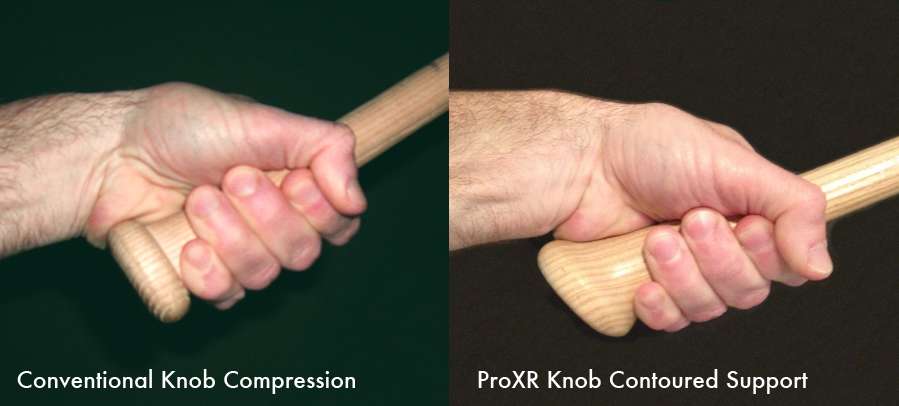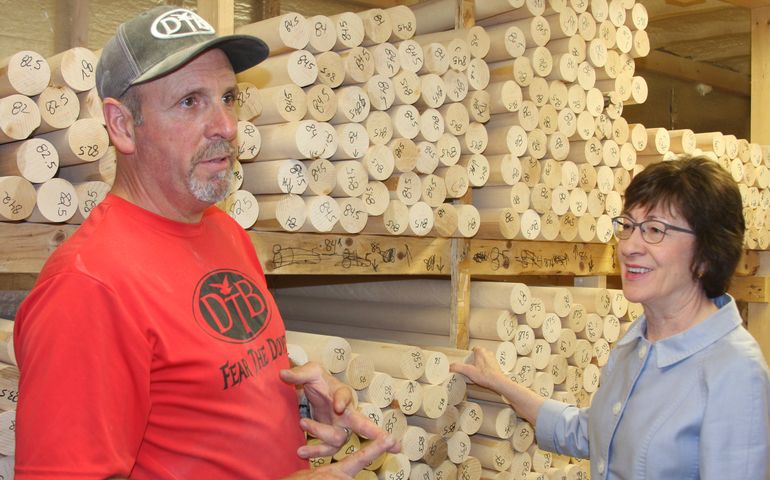
Maine manufacturer swings for the fences with radical baseball bat
 Courtesy / Office of U.S. Sen. Susan Collins
Paul Lancisi, CEO of Dove Tail Bats, shows U.S. Sen. Susan Collins, R-Maine, around the company's Shirley Mills facility in 2017. Dove Tail forms the billets pictured here from Maine-grown hardwood, then shapes them into bats.
Courtesy / Office of U.S. Sen. Susan Collins
Paul Lancisi, CEO of Dove Tail Bats, shows U.S. Sen. Susan Collins, R-Maine, around the company's Shirley Mills facility in 2017. Dove Tail forms the billets pictured here from Maine-grown hardwood, then shapes them into bats.
More Information
It may be a while before you see a Major League Baseball player step to the plate again, but a Shirley Mills manufacturer hopes that when batters are finally up, more of them will swing lumber carrying its logo.
Look carefully, though — the bats may not resemble others you’ve seen.
Dove Tail Bats LLC last week said it has licensed technology from a St. Louis company, ProXR, to produce a new line of bats with an angled knob, the small rim that protrudes from the end of the bat handle. Dove Tail already makes such bats. But the license could allow the 15-employee manufacturer, about 60 miles from the Canadian border in Piscataquis County, to double output with the distinctive feature.
"We are very excited to offer ProXR as an option on our bats," Dove Tail CEO Paul Lancisi said in a news release. "We have received a lot of early positive feedback from our professional players about the combination of our ultra-premium bats and the ProXR technology."
Approved for major-league use in 2006, the angled (or sometimes called asymmetric) knob is the first major design change to the baseball bat in over a century. The knob slants along the bat shaft rather than at meeting it squarely, like a bottle cap. The result, according to ProXR, is a more ergonomic grip for the batter and a more powerful, smoother and less physically stressful swing.
Dove Tail has produced angled-knob bats since 2015, and today is one of only a half dozen or so manufacturers in the niche.

The bats, currently made with specs licensed from Axe Bats, of Renton, Wash., account for about $100,000 of the Dove Tail’s $1.5 million in annual revenue, Lancisi told Mainebiz in an interview. Including conventional models, Dove Tail produces 30,000 bats a year, using ash, birch and maple exclusively from Maine loggers. Most models, including ones for the pros, cost $150 to $250.
Lancisi wouldn’t disclose details of the new licensing deal, but said he expects revenue from the ProXR bats to meet or surpass the Axe sales. The pandemic’s effect and the postponement of the pro season may delay the timetable, however.
"This year is a big question mark," he said.
Dove Tail is currently the only bat manufacturer with licenses from both ProXR and Axe, which both hold patents on angled-knob designs and are considered the industry’s go-to sources. Despite their potential competition, Lancisi hopes Dove Tail will be able to continue both licenses.
“I think there’s a market for both,” Lancisi said. “Why don’t we let the players decide?”
Making it to the bigs
Dove Tail manufactures products for players at every level. In fact, Lancisi and his wife, Theresa, started the business almost 15 years ago by making bats for their son’s high school and college teams. A custom furniture maker and a former pitching prospect for the Boston Red Sox, Paul Lancisi cut his first bat from maple stock that had been planed for a table leg.
The business grew, and by 2014 Dove Tail was making 3,500 bats annually. 2014 was also Dove Tail’s rookie year in the MLB, and in the 2015 World Series 70% of the champion Kansas City Royals' runs came from hits off Dove Tail products. With the help of financing from Brunswick-based Coastal Enterprises Inc., the company soon expanded its facility, ramped up production and entered the angled-knob market.
ProXR and Axe also started small.
ProXR dates to 2007, when inventor Grady Phelan got the idea for a better bat after one he was swinging slipped out of his hands and nearly hit his son. The company launched seven years later, and in addition to Dove Tail, ProXR now licenses its design to four other companies. Dove Tail is the only licensee in the Northeast.
Around the same time Phelan was developing his design, woodsman Bruce Leinert was inspired by the axes he used to create a bat with a similar handle. His design was eventually acquired by Baden Sports LLC, which both manufactures bats and licenses out the technology.
All the bat makers now tout the success of major-league players.who use their products.
New York Mets first baseman Pete Alonso used Dove Tail bats, with both angled and traditional knobs, in his 2019 debut season. He hit a first-year record of 53 home runs and was named the National League Rookie of the Year. In 2018, Red Sox right fielder Mookie Betts hit with an Axe bat and won the Most Valuable Player title. In 2018 and 2019, each of the five MLB players swinging bats with ProXR technology made their hardest hits ever, as measured by ball speed.
Angling for a break
But breaking into the majors can be as daunting for bat makers as it is for the players. The MLB currently permits just 37 manufacturers to turn out bats for its games, and suppliers must first pay application fees and insurance premiums totaling about $30,000.
Then there are traditions that date to the 1880s, when the world’s most famous bat, the Louisville Slugger, originated. Slugger bats today generate about $75 million in sales. But while designs have evolved a bit, most bats today are surprisingly similar to those of a century ago.
Despite the breakthrough performances in recent years, acceptance of the angled knob has been slow. Baseball is an old-school sport that takes to product innovation slowly. "It's like pushing string up a hill, attempting to bring change to age-old honored traditions,” Phelan told Inc. magazine in 2018.
Plus, the sport is one of small increments. Adjusting a batter’s grip by a fraction of an inch can mean the difference between a fly out and a home run. So players are naturally wary of change.
“[The angled knob] isn’t what they’ve grown up with, so it’s very foreign to them,” Lancisi said. “A lot of them will say, ‘no thanks.’ If your livelihood is relying on [a bat], it's a big thing."
Still, Dove is finding more players willing to give the unusual bat a try. Lancisi said players who have suffered a batting-related hand injury are especially receptive. So are those struggling in the batter’s box.
“A player hitting .225 will try just about anything,” he said. “And some of them then have great success with these bats.”

But perhaps the greatest potential market for the new bats isn’t in major-league players, but Little League ones. As angled-knob bats become more common in youth sports and in softball, future Hall of Famers may grow up accepting and appreciating the design.
“One of the biggest requests we’ve had is from parents who want a bat that helps protect their kids hands, and also helps give them some performance advantages," Phelan told USA Today in a 2014 interview. "The kids who have used it love it.”
Hugh Tompkins, director of research and development at Baden Sports, said, "We know we’ve designed a better bat, so our focus has been to get as many people using it as possible. As this generation of kids become adults, the pro level will take care of itself.”
At Dove Tail, where about 30% of sales are to the consumer market, Lancisi agreed. "Once we really get this out there, it's going to be huge," he said. "If baseball had introduced these bats 100 years ago, today no one would be using a traditional knob.”
Mainebiz web partners
Play ball! Puh-leese!










1 Comments